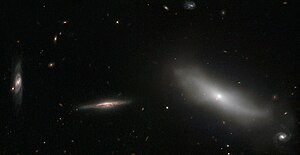NGC 1190
| Galaxie NGC 1190 | |
|---|---|
(c) ESA/Hubble, CC BY 4.0 | |
| Aufnahme des Hubble-Weltraumteleskops: NGC 1190 ist rechts, die anderen Galaxien sind Hintergrundobjekte. | |
| AladinLite | |
| Sternbild | Eridanus |
| Position Äquinoktium: J2000.0, Epoche: J2000.0 | |
| Rektaszension | 03h 03m 26,1s [1] |
| Deklination | −15° 39′ 43″ [1] |
| Erscheinungsbild | |
| Morphologischer Typ | S0[1] |
| Helligkeit (visuell) | 14,2 mag[2] |
| Helligkeit (B-Band) | 15,2 mag[2] |
| Winkelausdehnung | 0,9′ × 0,3′[2] |
| Positionswinkel | 95°[2] |
| Flächenhelligkeit | 12,4 mag/arcmin²[2] |
| Physikalische Daten | |
| Zugehörigkeit | HCG 22[1] |
| Rotverschiebung | 0.008733 ± 0.000090[1] |
| Radialgeschwindigkeit | (2618 ± 27) km/s[1] |
| Hubbledistanz H0 = 73 km/(s • Mpc) | (115 ± 8) · 106 Lj (35,2 ± 2,5) Mpc [1] |
| Durchmesser | 30.000 Lj[3] |
| Geschichte | |
| Entdeckung | Francis P. Leavenworth |
| Entdeckungsdatum | 2. Dezember 1885 |
| Katalogbezeichnungen | |
| NGC 1190 • PGC 11508 • MCG -03-08-062 • 2MASX J03032612-1539429 • HCG 22B • GALEXASC J030326.14-153942.4 | |
NGC 1190 ist eine linsenförmige Galaxie vom Hubble-Typ S0 im Sternbild Eridanus am Südsternhimmel. Sie ist schätzungsweise 115 Millionen Lichtjahre von der Milchstraße entfernt und hat einen Durchmesser von etwa 30.000 Lj. Gemeinsam mit NGC 1189, NGC 1191, NGC 1192 und NGC 1199 bildet sie die Galaxiengruppe HCG 22.
Das Objekt wurde am 2. Dezember 1885 von dem US-amerikanischen Astronomen Francis Preserved Leavenworth entdeckt.[4]
Weblinks
Einzelnachweise
Auf dieser Seite verwendete Medien
(c) ESA/Hubble, CC BY 4.0
This new Hubble image shows a handful of galaxies in the constellation of Eridanus (The River). NGC 1190, shown here on the right of the frame, stands apart from the rest; it belong to an exclusive club known as Hickson Compact Group 22 (HCG 22).
There are four other members of this group, all of which lie out of frame: NGC 1189, NGC 1191, NGC 1192, and NGC 1199. The other galaxies shown here are nearby galaxies 2MASS J03032308-1539079 (centre), and dCAZ94 HCG 22-21 (left), both of which are not part of HCG 22.
Hickson Compact Groups are incredibly tightly bound groups of galaxies. Their discoverer Paul Hickson observed only 100 of these objects, which he described in his HCG catalogue in the 1980s. To earn the Hickson Compact Group label, there must be at least four members — each one fairly bright and compact. These short-lived groups are thought to end their lives as giant elliptical galaxies, but despite knowing much about their form and destiny, the role of compact galaxy groups in galactic formation and evolution is still unclear.
These groups are interesting partly for their self-destructive tendencies. The group members interact, circling and pulling at one another until they eventually merge together, signalling the death of the group, and the birth of a large galaxy.
A version of this image was entered into the Hubble's Hidden Treasures image processing competition by contestant Luca Limatola.
